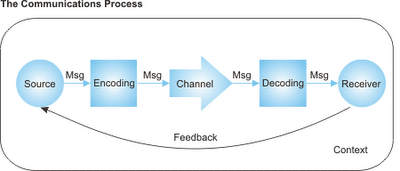Selecting appropriate mediums, channels and technologies
This takes place at the level of conceptualization.
When a sender decides to encode a message, he or she must take two main things into consideration during this stage – the context and the audience (receiver). These factors influence both choice of medium and choice of channel. The key word here is appropriateness. Choice of medium and channel are directly influenced by the purpose of the message and the intended audience. Ask yourself the following questions when determining levels of appropriateness:
i. Who is my receiver?
ii. How best can my message be conveyed?
iii. Where is the communication act taking place?
iv. What is the situation surrounding the communication act?
v. Is my audience one person or several?
vi. What medium should I use, oral or written?
vii. Should I use technology? If so, which technology would most appropriate?
Scenario 1
Read the scenario below and answer the questions that follow.
Greg is ill and has to be away from school for two weeks. His mother encodes a letter to the school principal and sends it out in the mail.
In the above situation,
1. How else could Greg’s mother have gotten the message to the Principal?
2. Why do you think she chose to write a letter?
Answer: The telephone or email could have been used. She chose the letter because a letter is a more formal medium of communication and can serve as a permanent record.
Facilitators &; Barriers to Communication
Noise is anything that interrupts or blocks the flow of information. Whenever the understanding of a message is affected, the obstruction is considered a barrier to communication.
Some common barriers to communication are:
i. A language barrier
ii. A channel that is inaccessible to the receiver
iii. The message is ineffectively encoded or the meaning is ambiguous
iv. The medium is inappropriate to the message
Some common facilitators to communication are:
i. Choosing a familiar language
ii. Using an accessible channel
iii. Ensuring that the medium is appropriate to the message
iv. Using audio/visual aids to enhance the encoding of the message
Showing posts with label noise. Show all posts
Showing posts with label noise. Show all posts
The Communication Process & The Elements of Communication
Communication as a Process
Human communication is interpersonal, it is purposive and it is a process.
Question: What do we mean by process?
Answer: By process we mean that steps have to be taken and in a set/particular order to achieve a desired result/goal. These are the important elements of the communication process:
1. SENDER/ENCODER
The sender also known as the encoder decides on the message to be sent, the best/most effective way that it can be sent. All of this is done bearing the receiver in mind. In a word, it is his/her job to conceptualize.
The sender may want to ask him/herself questions like: What words will I use? Do I need signs or pictures?
2. MEDIUM
The medium is the immediate form which a message takes. For example, a message may be communicated in the form of a letter, in the form of an email or face to face in the form of a speech.
3. CHANNEL
The channel is that which is responsible for the delivery of the chosen message form. For example post office, internet, radio.
4. RECEIVER
The receiver or the decoder is responsible for extracting/decoding meaning from the message. The receiver is also responsible for providing feedback to the sender. In a word, it is his/her job to INTERPRET.
5. FEEDBACK
This is important as it determines whether or not the decoder grasped the intended meaning and whether communication was successful.
6. CONTEXT
Communication does not take place in a vacuum. The context of any communication act is the environment surrounding it. This includes, among other things, place, time, event, and attitudes of sender and receiver.
7. NOISE (also called interference)
This is any factor that inhibits the conveyance of a message. That is, anything that gets in the way of the message being accurately received, interpreted and responded to. Noise may be internal or external. A student worrying about an incomplete assignment may not be attentive in class (internal noise) or the sounds of heavy rain on a galvanized roof may inhibit the reading of a storybook to second graders (external noise).
The communication process is dynamic, continuous, irreversible, and contextual. It is not possible to participate in any element of the process without acknowledging the existence and functioning of the other elements.
Subscribe to:
Comments (Atom)
Featured post
The Communication Process & The Elements of Communication
Systematic=Step by Step=Process Communication as a Process Human communication is interpersonal, it is purposive and it is a process....

-
Difference between 'Language' and 'a language' Language refers to a system of communication unique to human beings that m...
-
Systematic=Step by Step=Process Communication as a Process Human communication is interpersonal, it is purposive and it is a process....
-
Register refers to the perceived attitude and level of formality associated with a variety of language. The relationship between the writer...
